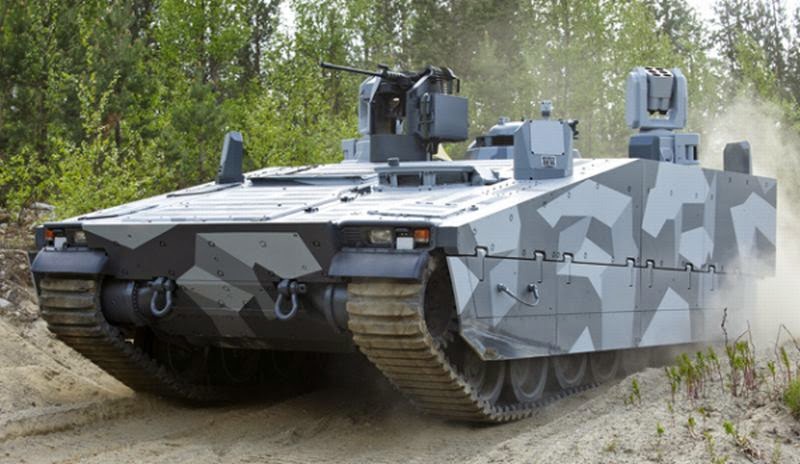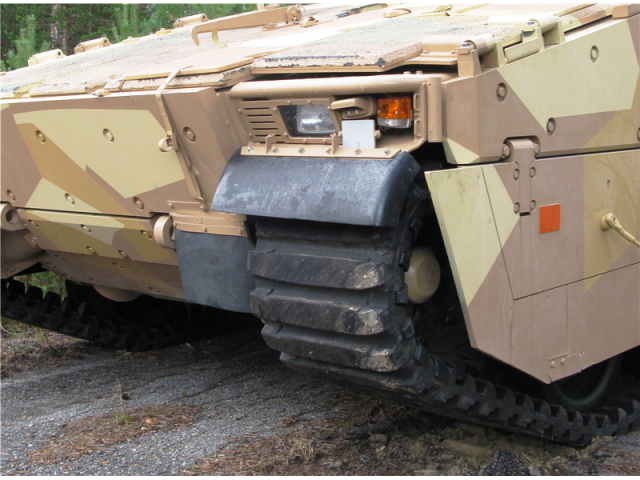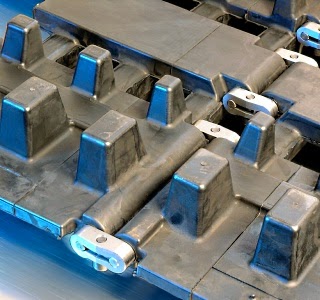Rubber Band Tracks:
The Future of Tracks?..
Tracked vehicles offer superior mobility on rough terrain, that is for sure. However, anyone who has ever ridden inside a tracked vehicle never forgets the experience... The vibration and noise coming from the tracks is surely something you remember later on. Especially when you ride on road...
The vibration inside a tracked armored vehicle has adverse effects on the crew health and fatigue. Today the tracked vehicle crews usually take a 20 minute rest after riding inside the vehicle for 1.5-2 hours.
The Whole Body Vibration (WBV) witnessed by the crew, refers to vibrations transmitted by the body’s supporting surface, such as the legs when standing and the back when sitting. Short-term WBV can cause chest discomfort, nausea, headaches and fatigue, while long-term exposure can lead to serious health problems mainly affecting the lumbar spine and connected nerves systems (Occupational Health Clinics for Ontario Workers Inc, 2005). (1)
Travelling inside the armored vehicle on steel tracks can shake the soldiers inside to the point of exhaustion, according to Dan Goure, a military analyst at the Lexington Institute, a think-tank in Arlington, Virginia. And J.G. Brunbech, an APC expert at the Danish Army Material Command in Oksboel, observes that the crew's limbs are prone to becoming prickly and numb, and their hands get tired, because they must grip the vehicle's safety handles tightly. (2)
Conventional Steel Tracks
The high vibration levels induced by steel tracks also impart stresses that wear out the equipment inside the vehicle, especially the electronics.
Another important adverse effect of vibration is its impact on the stabilization system of the turrets. The stabilization system basically tries to overcome the disturbance coming from the vehicle to the barrel to keep it steady. On the tracked vehicles, the elevation axis stabilization performance is reduced and even on some vehicle speed levels, totally ruined especially on hard and flat surfaces like roads.
Rubber Band Tracks
Band tracks -sometimes referred as rubber endless tracks- differ from the conventional steel tracks with rubber pads.
Most rubber tracks are formed around a basic carcass or belt. The carcass includes an endless belt-shaped rubber-like elastic member, a number of core bars (usually of metal) embedded therein and aligned in the longitudinal direction thereof and extending in traverse directions thereof, and steel cords (tension-resistant members) embedded in the endless elastic member to surround the core bars circumferentially outwardly. (3)
Canadian M113A3 TLAV with Soucy Band Tracks
Band Track Experience
Rubber band tracks was started to be used in Hagglunds (Now BAE Hagglunds) in 2003 for Bv206 armored vehicles.
Bv206 Ambulance with Band Tracks
Afghanistan has been the proving ground for the band tracks.
Norwegian Army started deploying M113 vehicles with Soucy band tracks to Afghanistan in 2004. The band tracks that replaced the T130 tracks on the M113 weigh only 45% of the steel tracks.
Danish Army followed Norwegians with their uparmored M113G vehicles with Rafael Enhanced Applique Armour Kit and Soucy band tracks in 2009 and deployed those vehicles to Afghanistan.
Danish M113G with Soucy Band Tracks in Afghanistan
These deployments were actual operational testing of in theater and the band tracks proven themselves in the harsh environment of Afghanistan.
In 2010, Norwegian Army raised the bar one more step and deployed two CV9030N IFV vehicles to Afghanistan fitted with rubber band tracks.
Norwegian CV9030N with Band Tracks in Afghanistan
This created a first in terms of the vehicle weight levels that the band tracks applied. For CV90, the band tracks support a weight of 28 tons.
Soucy band tracks were also integrated on the US Army's Future Combat Systems Self-Propelled Howitzer, the 18 ton NLOS-C.
NLOS-C with Band Tracks
BAE Systems Hagglunds awarded a contract from Norwegian Army to provide 100 new CV90 vehicles and also upgrade the 44 vehicles of the existing fleet in June 2012. The contract covers the delivery of 144 vehicles in 5 different configurations from IFV to command and engineering vehicles.
These vehicles are also being fitted with band tracks.
Another Hagglunds vehicle with band tracks is the CV90 Armadillo APC, which is a contender for the Danish Army's M113 Replacement Programme.
CV90 Armadillo APC with Band Tracks
Lessons Learned
Thanks to the Nordic Countries of Denmark and Norway, the band tracks has proven themselves as strong alternatives to the conventional linked steel tracks. And the best thing is they are proven not in a controlled test environment, but in real life combat operations.
The operational testing has shown some very interesting results:
- Vibration levels reduced by 50-65%. British MOD study on CVR(T) with band tracks provided 50% reduction.(5)
- Noise levels reduced by 6-10 decibels (dB). TACOM/TARDEC study on band tracks for M113's showed the internal noise levels reducing to heavy truck cabin noise levels.
- Band tracks being around 30% lighter than steel tracks.
- More durable then steel tracks. M113 study has shown the life time doubling of the T130 steel tracks.
- They can provide better traction by being wider than steel tracks thanks to their weight advantage.
- Ground pressure levels reduced by the wider tracks.
- Band tracks are more friendly to the road surfaces causing no significant damage to road surfaces.
- Provide better fuel economy with their reduced rolling resistance. M113A3 with band tracks had 67% less rolling resistance than the T130 tracks.
- Lower rolling resistance equals better fuel economy.
- No corrosion to speak of with the band tracks.
US DoD study on M113A3 with band tracks showed that, M113A3 band track durability (the point at which track separation occurs) was approximately 4,700 kms when tested over 20% primary (paved) roads, 40% secondary (gravel) roads and 40% cross-country at a 12 tons GVW.9 (5)
CV90 with Band Tracks
However along with their significant advantages they are not without any drawbacks as well.
In terrain conditions with sharp stones they are more prone to damaging than the conventional tracks.
Especially the endless band tracks are significantly more difficult to replacement. Under combat conditions, replacing a band track would be a extremely difficult task for the crew.
Segmented Band Tracks
The solution to the assembly and storage problems with the endless band tracks came from the German Company Diehl with the so-called Segmented Rubber Band Track.
Diehl Segmented BandTracks
The new rubber band tracks can even be replaced in the field under operational conditions in a fraction of the time previously required. Furthermore, individual replacement segments can be transported on the vehicle so that vehicle mobility can rapidly be restored in case tracks are damaged. A new design of the main structure as well as the robust, high-traction rubber profile guarantee high service life in all climate zones and in various terrains.
Bv206S with Soucy Internal Drive Tracks(*)
Conclusion
The band tracks, thanks to continous development and operational testing by Nordic Armies, have become an attractive and available alternative to conventional linked steel tracks.
Although they have some drawbacks that needs some development, with the segmented band tracks, I believe they are s strong competitor to the steel tracks.
For armored vehicles in the 15-30 ton range and for some roles like reconnaissance where vibration and noise levels are very important for apparent reasons, band tracks would be a capability multiplier.
References:
(1)Hung, K., S., E,. "Reducing Vibration in Armoured Tracked Vehicles", DSTA Horizons.
(2) "Quiet Please", The Economist, Q4, 2008.
(3) Soucy International Patent, EP 1291270 B1, "Endless track for high speed multi-terrain vehicles"
(4) Diehl Defence, www.diehl.com
(5) Hornback, P., "Problems Persist, But Continuous Band Track Shows Promise in Light Armor Applications", Armor, Jan-Feb, 1999.
First Image: Defence Photography http://www.defencephotography.com/
* The caption BV-206 image was wrong. I've corrected it now. My thanks goes to Mr. Jennings from Soucy-Group.
(5) Hornback, P., "Problems Persist, But Continuous Band Track Shows Promise in Light Armor Applications", Armor, Jan-Feb, 1999.
First Image: Defence Photography http://www.defencephotography.com/
* The caption BV-206 image was wrong. I've corrected it now. My thanks goes to Mr. Jennings from Soucy-Group.
©2014 Warfare Technology











